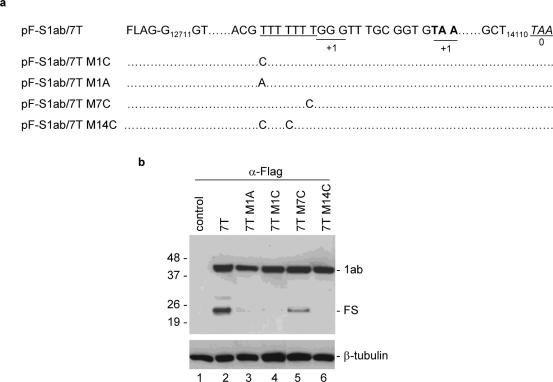Figure 6.
Differential effects of a downstream stimulator on frameshifting efficiencies mediated by wild type and mutant hepta-uridine stretch. (a) Diagram showing the structure of constructs pF-S1ab/7T, pF-S1ab/7TM1C, pF-S1ab/7TM1A, pF-S1ab/7TM7C and pF-S1ab/7TM14C. The seven T stretch is underlined. Also shown are the TAA termination codon for the +1 and 0 frames, and the mutations introduced into the seven T region. (b) Expression of pF-S1ab/7T (lane 2), pF-S1ab/7TM1A (lane 3), pF-S1ab/7TM1C (lane 4), pF-S1ab/7TM7C (lane 5) and pF-S1ab/7TM14C (lane 6) in Cos-7 cells. Cells were infected with the recombinant vaccinia/T7 virus and infected either with an empty control plasmid (lane 1) or each of the five constructs (lanes 2–6). At 18 h posttransfection, cells were harvested and lysates prepared. Polypeptides were separated on SDS–12% polyacrylamide gel and analyzed by western blot with anti-Flag antibodies. Bands corresponding to 1ab, the frameshifting products (FS) and β-tubulin are indicated. Numbers on the left indicate molecular masses in kilodaltons.

